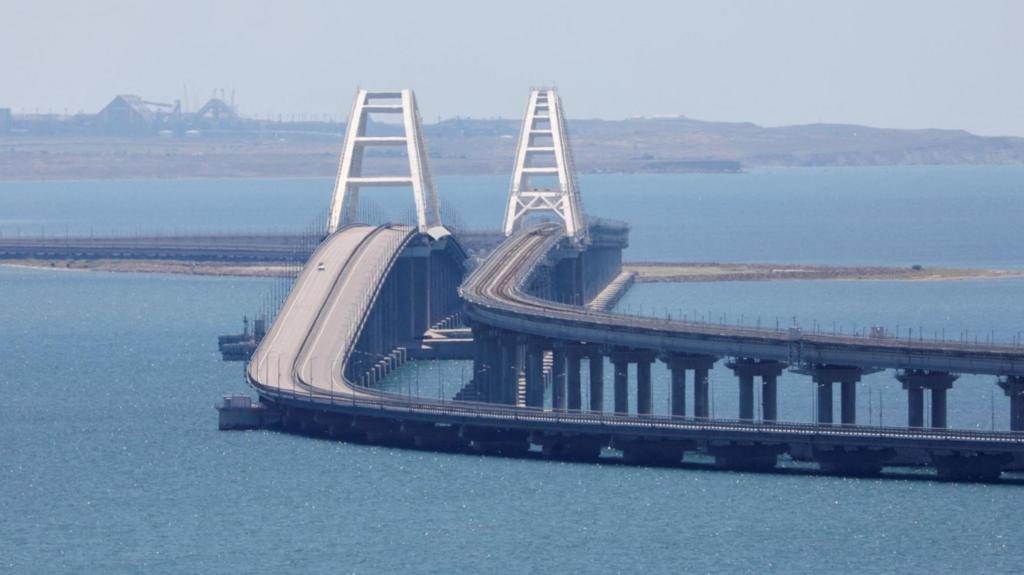Kerch Bridge Bombed Again: Ukraine’s Underwater Strike Halts Russian Traffic Across Crimea
Ukraine has claimed responsibility for a dramatic underwater explosion that halted traffic on Russia’s Kerch Bridge, striking a vital supply route connecting the mainland to annexed Crimea.
The attack, executed with 1,100kg of submerged explosives, marks the third strike on the bridge and a bold move in Ukraine’s strategy to disrupt Russian military logistics and symbolism.
Traffic on the Kerch Bridge a critical link between mainland Russia and the annexed Crimean Peninsula was abruptly halted on Tuesday after Ukrainian officials claimed responsibility for a targeted underwater explosion that struck the structure. The dramatic incident, confirmed by Ukraine’s Security Service (SBU), represents the latest escalation in Kyiv’s strategic effort to disrupt Russian supply chains and military logistics in occupied territories.

According to the SBU, the operation was months in the making. Ukrainian forces reportedly planted 1,100 kilograms of explosives deep underwater, carefully concealing the payload before triggering the detonation at approximately 5:00 a.m. local time. The targeted explosion, they say, damaged key underwater pillars of the bridge jeopardizing its structural integrity and once again interrupting Russia’s access to Crimea.
Maritime traffic in the surrounding area has also been suspended as Russian authorities assess the extent of the damage. While there has been no official statement from the Kremlin, the silence from Moscow stands in contrast to Ukraine’s confident announcement of the operation’s success.
The Kerch Bridge has long stood as a potent symbol of Russia’s annexation of Crimea in 2014. Opened in 2018 and spanning nearly 19 kilometers over the Kerch Strait, it has served not just as a logistical supply route for Russian military operations in southern Ukraine but also as a political declaration of Russia’s control over the disputed peninsula. Ukraine, which does not recognize the annexation, considers the bridge a legitimate military target and has now reportedly targeted it three times since the war began.
This latest strike comes amid a series of recent and unexplained infrastructure failures inside Russia. Just days before the Kerch incident, a bridge in Russia’s Bryansk region collapsed on Saturday night. The destruction led to the deaths of seven people and left dozens injured when heavy freight trucks fell onto a passing passenger train below. Then, in the early hours of Sunday, another railway bridge in Kursk’s Zheleznogorsk district also collapsed, causing a locomotive to derail.
Russian media have described both collapses as suspected acts of terrorism. However, Ukrainian officials have dismissed these suggestions as part of a wider Russian misinformation campaign. A Ukrainian national security official described the incidents as likely “false flag” operations designed to stir public emotion and influence international perception in the lead-up to Monday’s peace negotiations.
As suspicions swirl, analysts have pointed out that the tools used in the Kerch operation resemble those supplied by the United States to Ukraine in recent military aid packages. The U.S. State Department has previously acknowledged the provision of C-4 plastic explosives, demolition munitions, and underwater demolition equipment to assist Ukraine in its defense efforts. While no official link has been drawn between the aid and the latest attack, experts say the use of underwater explosives such as C-4 would align with the profile of the Kerch Bridge assault.
Meanwhile, uncertainty continues to hang over the situation, as Russian officials have yet to issue a comprehensive statement about the strike or provide visual evidence of the damage. The lack of response raises questions about the severity of the structural harm and whether restoration work can proceed in the coming days.
For Ukraine, the strike marks a psychological and tactical victory. Damaging the Kerch Bridge arguably one of Russia’s proudest infrastructural achievements in Crimea deals a symbolic blow to Russian President Vladimir Putin’s grip over the region. For Russia, however, the recurring attacks raise uncomfortable concerns about the vulnerability of its logistics infrastructure even deep within its own or annexed territory.
As both sides brace for the next phase of the conflict, the Kerch Bridge incident serves as a reminder that the war is being fought not just on open battlefields but also through covert, high-stakes sabotage operations beneath the surface literally and figuratively.



